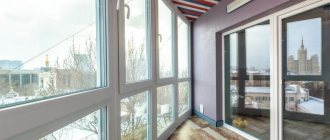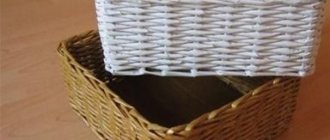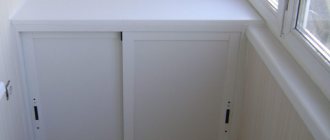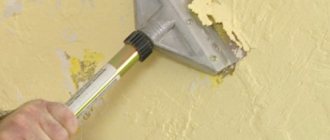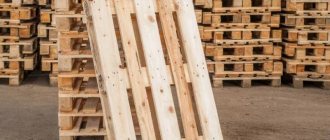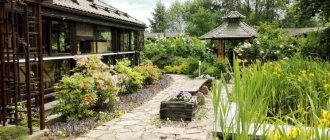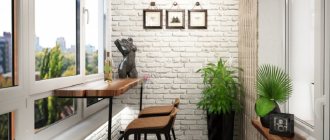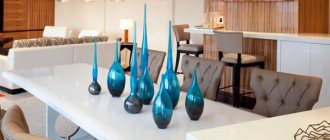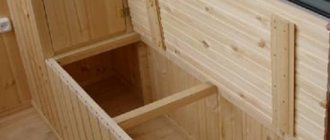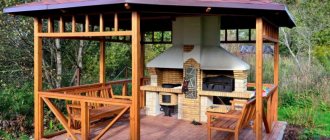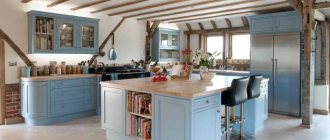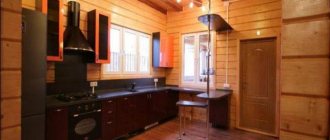Beautiful and environmentally friendly material
Decorating the balcony with wooden paneling is the right decision! This material consists of boards with grooves processed in a special way. Both regular and eurolining are available for sale. What is their difference?
Eurolining is a processed board with grooves, a profile and a connecting tongue. The material is durable provided it is used without direct sunlight and in the absence of moisture.
The profile differs in quality, width and thickness. Regular lining is not subjected to additional drying and is sold with the natural moisture content of the wood.
The manufacturing technology of eurolining requires mandatory drying.
When processing it, special grooves are cut to drain condensate and relieve stress from the installed finishing material. Such panels last longer, but they are also more expensive.
How to finish the floors in the gazebo
Now let's look at the materials that can be used to finish the floors inside the gazebo. Among other things, the following technologies are known:
- Backfill.
- Clay floor.
- Tree.
- Paving slabs.
- Porcelain tiles.
Let's also consider the features of these technologies.
Backfill
This method is ideal for finishing open gazebos, as can be seen in the photo in this section. Various materials can be used here, for example, sand, crushed stone, fine gravel and even compacted soil
However, it is important to be prudent here. Weeds and grass will grow through such a coating
Therefore, before filling, be sure to remove a layer of fertile soil, usually about 200 mm, and also lay geotextiles, possibly in two layers.
Clay floor
An equally interesting option is with an adobe floor. To implement it you need straw, clay and water. A layer of crushed stone is poured onto the ground, and a layer of adobe mixture up to 70 mm is applied on top. The clay mixture should be thick
It is important to evenly distribute the clay over the entire surface of the floor inside the gazebo. Also note, it is necessary to organize a reliable shelter so that the rain does not wash away the clay
As you can see, although the option is budget, it is dubious.
Tree
Wooden flooring is often used when finishing a gazebo. To do this, it is necessary to install logs, as well as make flooring from a floorboard. This material can also be used for cladding walls and finishing the ceiling of the gazebo. Before using wood, all workpieces should be treated with an antiseptic against rot and mold.
Paving slabs
Paving slabs are a reliable finishing material for floors. It is durable and able to cope with the negative effects of moisture and other atmospheric phenomena. To prevent falls, it is better to choose paving slabs with a rough surface. Its installation is very simple.
Porcelain tiles
Porcelain tiles are also an original solution for floor finishing. Some people also use porcelain tiles to decorate the walls of a brick gazebo. For example, it can be used to treat the working surface of a barbecue, if there is one inside the gazebo. Porcelain tiles are resistant to mechanical stress and are also not susceptible to rotting. The cost of porcelain tiles is considerable, so not everyone will be able to purchase them. Moreover, you must first make a high-quality and smooth concrete floor. After installing the tiles on the floor, all seams should be treated with moisture-proof grout to eliminate the possibility of moisture penetrating into the screed.
Kinds
The quality indicators of this material are divided into 4 categories. This natural facing material is presented by manufacturers in different configurations: block house (like a log), imitation timber, seamless wall, landhouse (the front side is milled, thanks to which a unique pattern is visible on the surface), calm (inconspicuous seams on the surface), etc. d.
There are different shapes of cladding boards. In production, they are processed on various woodworking machines. The result is a lining surface that creates different patterns on the sheathed wall.
Painting lining in a protected space
Compositions for interior work perform more of a decorative function than a protective one.
A balcony closed on all sides allows the finishing coating to work in comfortable, less aggressive conditions. They are close to the internal parameters of a home, differing in greater humidity and temperature changes. Therefore, painting the lining on the balcony is done with appropriate materials.
Paints for interior work are characterized by lower weather resistance, reduced release of aromatic substances, and pronounced aesthetic properties. In composition they are similar to paints and varnishes used externally. The absence of aggressive environmental factors allows you to concentrate on preserving the texture and appearance of natural wood, giving the room naturalness and comfort.
Make sure that the air temperature during operation corresponds to the paint, enamel or varnish recommended by the manufacturer.
This will allow you to correctly estimate the drying time of the layers before applying subsequent layers or starting operation. To learn how to paint lining inside a house, watch this video:
Varnishes and paints with low hiding power
Special colorless and tinted translucent organic or polymer-based impregnations and varnishes are optimally suited to this task. The factor influencing the choice of the type of painting material will be your own idea of the beauty of the surface and the perception of the comfort it creates. For information on how to coat wood, watch this video: The protective and performance characteristics of varnishes and paints from market-proven manufacturers are close to each other and meet the requirements for painting.
The wood to be varnished must be smooth and free of flaws.
The quality of painting lining on a closed balcony has a greater influence on the selection of wood that is free from flaws and defects, the thoroughness of surface treatment, and the accuracy of painting. Particular attention should be paid to these criteria when applying varnish.
This is quite a complex job that requires understanding and experience, as a result of which it is possible to create an even, deep layer of transparent coating that pleasantly refracts light and does not create glare for tired eyes.
Application of varnish may require additional manual sanding of the surface, as the visual perception of the hairiness of the material increases.
Using these general recommendations, you will be able to make a more competent decision about how to paint the lining on the balcony, assessing the features of the upcoming work front and your strengths.
Simple activity
You can sheathe the balcony by hiring workers. But if you have some woodworking skills, you can handle the task yourself.
Covering a balcony with clapboard with your own hands is a very simple task for a beginner. You just need to know some of the nuances of this matter.
Note!
- Sofa on the balcony: functions and advantages of a sofa on the balcony. Selecting a model, size and shape. DIY instructions (photo + video)
- Brick balcony - modern projects and recommendations on how to decorate a balcony with brick (175 photos)
Clothes dryer for the balcony - 105 photos of modern models and video instructions for their installation
Cork
This material is very popular for finishing the inside of a balcony. Cork is produced in the form of sheets of crushed and compressed cork tree bark, which is covered with veneer. The advantage of cork compared to wood is that it does not require regular treatments and maintains the microclimate. In addition, it is worth noting the environmental safety of the material, since it is not only harmless, but also useful for people who have respiratory tract diseases. Cork is also great for allergy sufferers and does not cause any diseases.
In general, the choice of materials is large, it all depends on the style, interior and unity of style in the house. Only the owner himself decides which material to choose, taking into account personal tastes, advantages and disadvantages of the materials that were given as an example above. If you approach this matter responsibly, you can create not only a beautiful balcony, but also carry out high-quality finishing in order to make the space as efficient and functional as possible.
Preparing the walls
Before covering the balcony with clapboard, you need to prepare the walls. In order for the material to attach well and not warp in the future, the surface of the walls must be flat.
If there are cracks, they are sealed with cement mortar, the unevenness is eliminated and the entire area under the lining is treated with an antifungal drug.
Design features of the balcony
If the balcony is well insulated, then it can become a full-fledged living room.
The first condition taken into account when choosing paint and varnish materials is to assess the position of the surfaces being treated - whether they are located outside or inside the room. The apparent obviousness of the answer, since the balcony is located behind the outer surface of the building wall, can be misleading.
If the balcony space is completely isolated from atmospheric influences by a fencing belt and glazing, then it is permissible to consider it as an internal space of the home and use appropriate materials.
Preservation of the original design, in which the facade wall of the house, the floor of the balcony and the inside of the fence are exposed to weather factors, which requires choosing from a different range of paint and varnish coatings intended for external use.
Insulation
For insulation, it is better to take a special foil-based material “Penofol” or “Izolon”, which is produced in rolls or slabs. The insulation is attached to the walls after completing the preparatory work.
A frame of slats is mounted on top of the insulating material. If the balcony is insulated with expanded polystyrene or polystyrene foam, sheets of this solid material are attached between the slats after the installation of the wooden frame is completed.
Frame
When constructing a frame, first vertical slats are attached to the wall, then horizontal ones. Using a drill or hammer drill, holes with a diameter of 6-8 mm and a depth of up to 5 cm are drilled through the rail in the wall.
Note!
- Shelves on the balcony - practical ideas and detailed instructions on how to install and where best to place the shelves (115 photos)
Furniture for balconies - 125 photos and video descriptions of real examples of design of balconies and loggias
Wardrobe on the balcony - features of the wardrobe on the balcony. Advantages and disadvantages. Varieties of cabinet models for balconies. Manufacturing and installation of a cabinet by hand (photo + video)
Then the wooden structural element is attached to the wall using dowels, which are tightened with a screwdriver or screwdriver.
Horizontal slats are installed at a distance of 50 cm from each other, vertical slats - 1 m. Before fixing the slats, check its level.
A vapor barrier material is fixed on top of the constructed frame. Now you can cover the balcony with clapboard.
Facing
Sheathing of balconies and loggias is carried out only after preliminary treatment of all walls with a special water-repellent primer. Otherwise, they will be covered first with condensation and then with mold.
For the finishing of the balcony room in question, it is necessary to prepare a number of tools and materials, including:
- nails – 30 mm;
- dowels - take elements measuring 6x60 mm with significant curvature if the walls are smooth, otherwise choose longer options - 6x100 mm;
- self-tapping screws – 90 mm, 75 mm, 50 mm;
- eurolining - 40x70x3000 mm;
- cladding made according to the standards of GOST 8486-86, as well as GOST 8242-88, or cladding DIN 68126/86;
- drill, you can use a hammer drill;
- several drills for concrete, the desired size is 4 and 6 mm;
- level (spirit level);
- electric screwdriver;
- jigsaw;
- corner, steel measuring tape, pencil for marking;
- hacksaw;
- axe, hammer.
First check with a spirit level whether the walls on the balcony are even. If the upper part of the frame for installing the lining must be larger than the lower, then assembly must begin with the lower guide.
Saw off the guides to the desired length, and then mark the locations for the dowels every 60 cm, using a pencil. Drill holes 5-6cm deep using a 6mm drill bit.
The assembly of the sheathing frame should begin with the corner posts. First fasten the vertical and then the horizontal slats. Before starting installation, it is advisable to treat them with a fire retardant. Typically, such compositions are universal; in addition, they protect the wood from rotting. The frame can be painted.
Temporarily secure the guides and check the level of the structure. If everything is correct, hammer in the dowels and tighten the screws.
Place the straps behind the cords, stretched vertically. Repeat the procedure for the horizontal stripes. Insulation must be placed in the resulting cells.
When finishing a balcony with clapboard, you can secure the lining with nails. The first board is attached to the adjacent wall, then checked for level. Fasten the backing securely with nails into the grooved ridge, working carefully and timing each blow.
Measure the distance in the opposite corner from the beginning of the ridge so that the boards fit together easily. This creates a small gap between the wall and the floor, but it is easily covered with a plinth and will not be visible later. After installing 5-6 belts, make sure that the insulation is positioned vertically. Locking on the bars allows you to adjust the accuracy of installation within a small range.
When choosing the direction of cladding (horizontal or diagonal finishing), it should be taken into account that horizontally laid eurolining will make the room visually wider, and vertically laid, accordingly, higher.
After installing the corner post, you can proceed to leveling the vertical rods, and then fastening the lining to the walls with anchor bolts and attaching the longitudinal rods, placing them in increments of 500 mm.
If the insulation is placed inside the frame, then a vapor-proof film is mounted on top, only after that the lining is attached on top.
It is better to choose a window sill that is made of plastic, since dirt and dust are easily washed off from its surface. To do this, you should only use a soft sponge with detergent. In a few years, a wooden window sill will darken sharply next to the opening window frame.
After finishing the finishing work, the sheathed wall of the balcony should be coated with special compounds that will prevent the appearance of mold inside and give the wood an attractive appearance. Antiseptics, oil or acrylate paints, acrylic or alkyd varnish are suitable for these purposes. The lining itself can be impregnated several times. Special products have moisture-repellent properties, preventing the formation of mold, mildew and pests. By the way, protective products can be lightly shaded or rich in color.
Floor boards are prepared in the same way as beams for a frame; insulation is laid between them. Attach the floorboards to the joists using screws. This method of fastening allows you to correct the position of the boards after some time if cracks appear between them. If the floor squeaks, the screws need to be tightened.
Installation of lining
You need to start work on fastening the lining from the corner. Using a level, the ideal horizontal line of the first rail is set.
Then a special fastener (kleimer) is installed in the longitudinal groove of the board and carefully secured with a nail using a hammer.
Note!
- Window sill on the balcony - functions and advantages of a window sill on the balcony. Types of window sills. Choice of material. Methods of fastening and installation (photo + video)
- Decorating a balcony with stone: 145 photos and video description of how to decorate a balcony in a stylish and beautiful way
Living room with a balcony - 115 photos of the best ideas and beautiful combinations of a balcony with a room
In a similar way, the clamps are attached to the slats along the entire height of the first board. You can securely fasten the lining with self-tapping screws. But in this case, the aesthetic appearance will be spoiled by the caps remaining on the outside of the wood.
With this method, the screwdriver force must be set within the minimum position, otherwise, when tightened tightly, the wood may crack.
Haste is inappropriate
Each subsequent lining is attached to the previous one, first by joining the groove, then fixing it with nails or self-tapping screws.
You need to be extremely careful when working with nails or screws, since this wooden material is very delicate, especially in the grooves.
After completing the work, it remains to install skirting boards along the entire perimeter, which will cover the corner seams and uneven ends of the panels at the level of the floor and ceiling.
Interior siding, pros and cons
Siding is a structural panel that is used for finishing walls, balconies, bathhouses and other low-rise buildings, both externally and for internal cladding.
Decorative sheets differ both in quality characteristics and in purpose (external and internal).
Advantages of indoor siding:
- Lightness of elements;
- easy installation;
- mechanical stability;
- heat resistance;
- Do not over-level the surface under the siding;
- a wide range of;
- easy to care for;
- the ability to hide communications behind panels;
- durability;
- color fastness;
- the ability to replace damaged panels without much effort, without removing the entire paneling;
- the ability to install insulation on the surface of sections;
- reasonable price of the material.
The disadvantages of siding include the relative fragility of the material. With strong mechanical action on the coating, it may be damaged (formation of cracks - for PVC elements, significant irreparable dents - for metal sections).
It is not recommended to install siding elements near a gas stove, since the proximity of a fire can cause the panel to deform over time when melted.
Siding sheets for interior decoration are classified depending on the material they are made from:
- Vinyl;
- metal (copper, steel, galvanized);
- wooden;
- fiber cement.
In addition, the siding covering can be installed horizontally or vertically.
Interior siding
Interior Vinyl Siding
For interior decoration, vinyl structures are the most popular. Vinyl or polyvinyl chloride (PVC) material has good technical and positive quality characteristics.
PVC panels have a variety of textures and are distinguished by a wide range of colors, patterns, and styles. Vinyl siding for interior decoration can imitate natural wood, metal, or brickwork.
Vinyl sections have their own characteristics that attract the buyer:
- Resistance to rotting, corrosion, peeling;
- relative strength to mechanical stress;
- resistance to temperature changes;
- easy to wash and clean;
- color saturation;
- ease of installation and transportation.
Interior Vinyl Siding
Interior metal siding
The sheets can also be copper. The covering for metal sheets can be made of polyester, plastisol or pural. The structure of metal panels can be smooth or have a figured texture.
Their metal sheets are more durable than their PVC panels. They are distinguished by significant weight, which must be taken into account when installing on insufficiently strong walls.
Distinctive features of metal cladding:
- High strength;
- moisture resistance;
- wide color range.
The disadvantage in weight of metal panels is compensated by their high strength, so metal siding is no less popular than vinyl, although the cost of these panels is much higher than the cost of PVC coating.
Interior metal siding
Interior wood siding
It is believed that wooden panels are the most environmentally friendly, as they are made from natural organic raw materials.
In order for wooden panels to be the most durable, stable and attractive, they are treated with specific solutions and impregnations that protect the wood from rotting, moisture and corrosion.
Nevertheless, it is advisable to install wooden panels in places in a well-ventilated room, despite special treatment with antiseptics.
In addition to the fact that wood looks aesthetically beautiful and rich, it gives a feeling of warmth and comfort. Wooden siding helps to enhance sound insulation, as it is characterized as a heat-saving material.
A distinctive feature of wooden siding is its care: do not neglect to sometimes use impregnation or varnish to ensure the durability of the coating.
Protective covering
When the paneling of the balcony is completed, you can begin the final stage of work.
It includes the mandatory application of a special coating to the tree. This will protect it from ultraviolet radiation, the appearance of harmful mold, and emphasize the impeccable structure of the natural material.
Suitable antiseptics and paint coatings are widely available in all hardware stores.
